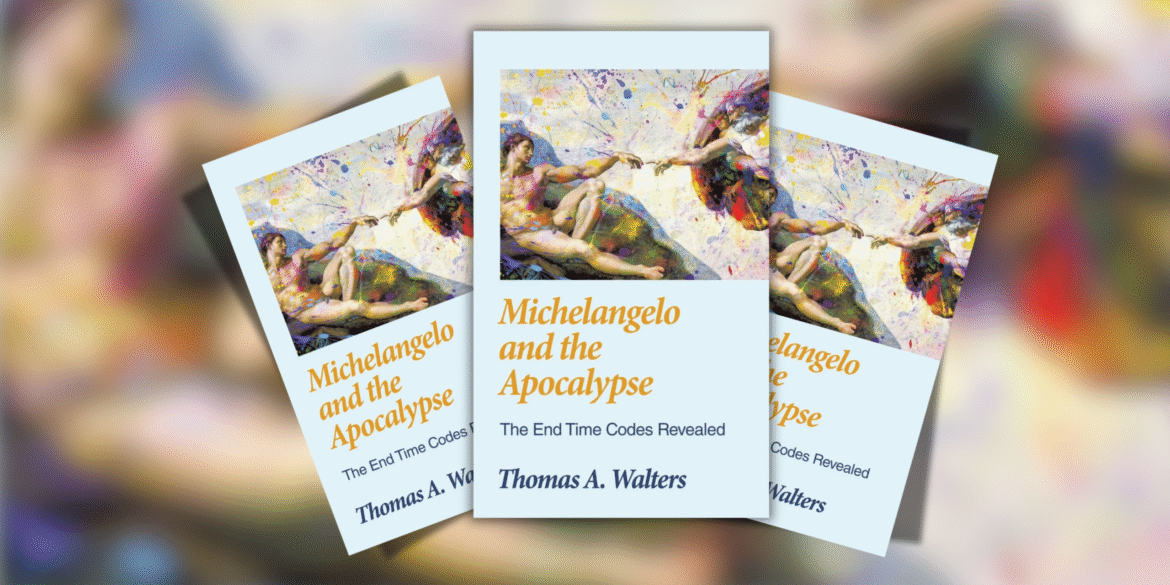At the heart of the Renaissance, amidst an era marked by profound cultural, religious, and artistic transformation, one name stands apart: Michelangelo Buonarroti. His legacy as one of the greatest artists in history is firmly cemented through masterpieces such as the David, the Pietà, and the monumental ceiling frescoes of the Sistine Chapel. Yet, within the grandeur of his artistic output, one work in particular, the Sistine Chapel Ceiling has long been the subject of intrigue, both for its breathtaking visual complexity and its possible deeper meanings. Was there a hidden, prophetic language embedded in his frescoes, a cryptic message about the Apocalypse and the end of days? Could Michelangelo, a deeply religious man, have encoded his vision of the end times within his artwork? Thomas Walters’ book, Michelangelo and the Apocalypse: The End Time Codes Revealed, explores this fascinating hypothesis in depth.
A Journey into the Heart of Michelangelo’s Vision
In Michelangelo and the Apocalypse, Thomas Walters offers an unprecedented and groundbreaking analysis of Michelangelo’s Sistine Chapel Ceiling by weaving together themes from the Book of Revelation, the Bible’s prophetic text on the end times, with the artist’s celebrated frescoes. Walters’ interdisciplinary approach blends art history, theology, and an analysis of symbolism to present a compelling narrative: that Michelangelo, through his artistic genius, might have been conveying more than just religious iconography or biblical stories. Rather, he could have been embedding a hidden language of prophecy, one that speaks to a divine orchestration of human history and the approaching end times.
The book draws its primary focus on how Michelangelo’s frescoes correspond with the Book of Revelation, exploring the parallels in structure, themes, and symbols. The Sistine Chapel Ceiling itself is an intricate visual symphony, encompassing an array of Biblical stories, from the creation of Adam to the fall of man. Yet, according to Walters, this masterpiece might also reflect a far deeper, apocalyptic narrative—one pointing to the grand finale of human history as foretold in the Bible.
Unraveling the Structural Dynamics: Codes of the Apocalypse
What makes Michelangelo and the Apocalypse stand out is its structural analysis of both the Sistine Chapel Ceiling and the Book of Revelation. The book suggests that the frescoes’ dynamic layout and sequence of images share a profound connection with the structure of the Book of Revelation itself. Just as Revelation progresses through a series of visions, seals, trumpets, and bowls, Michelangelo’s frescoes can be interpreted as a visual counterpart, divided into scenes that mirror the thematic and narrative progressions of apocalyptic prophecy.
For instance, the climactic image of the Last Judgment painted by Michelangelo on the altar wall of the Sistine Chapel, depicting Christ’s final judgment of the living and the dead, echoes the divine judgment described in Revelation. The image is both awe-inspiring and terrifying, yet profoundly human in its portrayal of the soul’s ultimate reckoning. Walters posits that Michelangelo, perhaps unwittingly, structured his artistic composition in a way that aligns with the eschatological themes of Revelation, building toward the inevitable final judgment of mankind.
Through careful analysis, Walters also explores how the frescoes may encode the Biblical story of humanity’s fall, redemption, and ultimate fate. The artist’s personal understanding of salvation and divine justice, combined with his unique artistic skill, could have led him to communicate a divine order that transcended simple Biblical narrative, engaging viewers in a larger cosmic drama.
The Mystical Dimension: Religion, Art, and Prophecy
Michelangelo’s relationship with religion, particularly Christianity, is well-documented, though it is often perceived as complex and, at times, tortured. A devout Catholic, Michelangelo wrestled with personal doubts and a sense of divine purpose throughout his life. His art, however, consistently conveyed a profound belief in the existence of a higher power, and the Sistine Chapel Ceiling stands as a testament to his devotion. Walters suggests that Michelangelo’s personal struggles with faith may have spurred him to contemplate the grand cosmic order more deeply, infusing his work with hidden meanings that transcend the traditional religious iconography of his time.
The artist’s depiction of Biblical events, especially in the context of divine judgment and the end of times, can be seen as a reflection of his inner theological concerns. In this light, Michelangelo and the Apocalypse proposes that Michelangelo may have been encoding, through his visual art, a prophetic understanding of the apocalypse, an understanding drawn from his contemplation of Scripture, art, and personal spirituality.
What Walters introduces through this book is a reinterpretation of the Sistine Chapel Ceiling, not merely as a religious or historical artwork but as a potential coded message, an artistic symphony of the end times. His argument is rooted in an interdisciplinary exploration of art history, religious studies, and even semiotics, presenting an intriguing possibility: that Michelangelo’s frescoes, intentionally or not, map out a prophetic vision of the end of days, drawing on both religious narrative and visual symbolism.
The Relevance Today: A Bridge Between the Past and the Future
The concept of an “end-time symphony,” as described in Walters’ work, takes on particular resonance in today’s world. As global uncertainty, environmental crises, and geopolitical instability persist, many look toward ancient prophecies and symbolic representations of the end of times for guidance or understanding. In this sense, Michelangelo and the Apocalypse offers more than just an academic analysis. it provides readers with a lens through which to view the present moment in relation to an apocalyptic past.
In uncovering Michelangelo’s potential prophetic intent, Walters’ book invites readers to not only revisit the Sistine Chapel and its mysteries but to consider how art and scripture can function together as tools for interpreting our place in the world. The idea that Michelangelo, centuries before, may have encoded a divine warning or message for the future adds a timeless quality to his work, making it profoundly relevant even today.
A Unique Contribution to Renaissance Art and Biblical Studies
Michelangelo and the Apocalypse is an essential read for those with an interest in Renaissance art, Biblical studies, and the intersection of religion and culture. Walters’ work introduces an exciting, fresh perspective on Michelangelo’s art, challenging established interpretations and offering a new way to understand his legacy. His analysis goes beyond the surface of the Sistine Chapel Ceiling, presenting it as a key to understanding not only Renaissance thought but the deep spiritual currents that shaped Michelangelo’s worldview.
For scholars of art history, religious studies, and interdisciplinary humanities, the book offers an innovative and thought-provoking approach to two of the most significant cultural artifacts in Western history. By combining art and prophecy, Michelangelo and the Apocalypse enriches our understanding of both the artist and the Biblical tradition.
A Call to Engage with the Divine
As the world continues to grapple with uncertainty and change, Michelangelo and the Apocalypse calls on its readers to reflect on the timeless themes of judgment, redemption, and divine order that Michelangelo may have embedded in his frescoes. Thomas Walters has crafted a narrative that not only deepens our understanding of the Renaissance artist’s work but invites us to engage with the questions of existence, spirituality, and prophecy that continue to resonate today.
For those eager to explore this captivating intersection of art, religion, and prophecy, Michelangelo and the Apocalypse offers a rich, intellectually stimulating journey. Walters’ meticulous analysis provides new insights that encourage further exploration into the mysteries of Michelangelo’s masterpieces. To discover how the artist might have encoded a divine message for the end times is to look deeper not only into his art but into the universal truths that transcend history itself.
Explore the codes of the apocalypse as revealed in Michelangelo’s art by diving into Michelangelo and the Apocalypse: The End Time Codes Revealed today, where art, prophecy, and the divine converge. You can find more information or purchase the book on Amazon.

